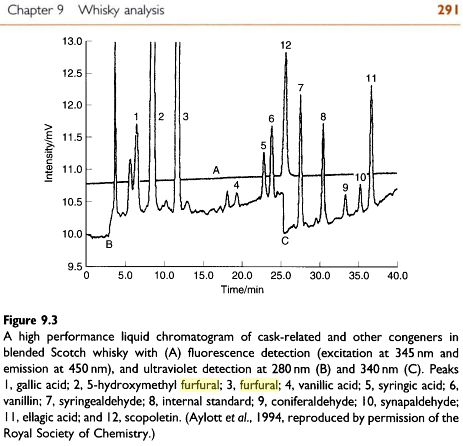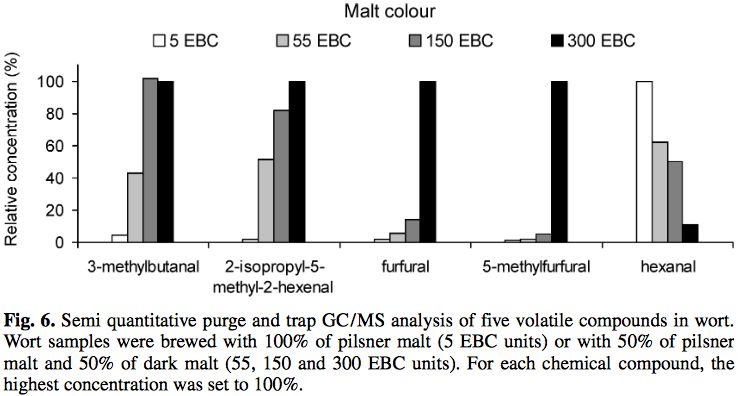
Welcome!
Be part of our community & join our international next generation forum now!
Categories
In this Discussion
- CothermanDistilling November 2015
- DocPorter November 2015
- FloridaCracker November 2015
- grim November 2015
- Kill_Devil_Spirit_Co November 2015
- punkin November 2015
- Unsensibel November 2015
Dark Roasted Malts as Furfural and 5-Methyl/5-Hydroxymethyl Furfural Adjunct?
This topic has come up a few times across the forums, with some who swear by it, and others that don't care for it. The biggest proponent, Darek Bell/Corsair, who had been active in the forums a few years back, and did offer this up as a recommendation:
At our distillery, Corsair, we use a lot of dark malts and believe heavily in the maillard reaction improving the finish of our whiskeys. We have experimented with about 60 different malts. One of my personal favorites is chocolate rye malt, if you add just 1% to the mash bill it comes over distillation and enhances the finish. I also like caramel 120. In international competitions, whiskey judges will judge your spirits on the nose, the body, and the finish. Dark malts add a slight caramel or chocolate note to the finish. Almost all our award winners had at least a hint of a dark malt in the mashbill.
I think the most common response to dark malts (when they are not overused, be cautious of this) - is that they add bitterness, chocolate, roast, and nutty flavors.
What got me interested in this when evaluating the organoleptics of blackstrap rum tails vs whiskey tails, specifically, the fact that rum tails carried over Furfural from the molasses manufacturing process, but whiskey did not contain any. Furfural is a product of the Maillard reaction, and would be common in foods that are roasted, charred, etc. You see Furfural in Coffee and Chocolate.
You also find Furfural and it's friend 5-Hydroxymethyl Furfural in roasted malts. And like in the rum tails, where the Furfurals carry over in the distillate, when using roast malts in a whiskey, they will carry over in the distillate.
(From GoodScents)
- Furfural Odor: Sweet, brown, woody, bready, caramellic, with a slight phenolic nuance
- Furfural Taste: Brown, sweet, woody, bready, nutty, caramellic with a burnt astringent nuance
- 5-Hydroxymethyl Furfural (HMF) Odor: fatty
- 5-Hydroxymethyl Furfural (HMF) Taste: herbal hay tobacco
- 5-Methyl Furfural Odor: Spice Caramel Maple
- 5-Methyl Furfural Taste: Sweet, Brown, Caramelic, Maple
Interestingly, HMF is very common in baked bread, where upon baking, the HMF increases significantly, for example:
Browning indicators in bread @ NCBI
Bread is the most important food in the Spanish household and represents the largest proportion of products produced by commercial bakeries. The browning indicators furosine, hydroxymethylfurfural (HMF), and color were determined to evaluate heat effects induced during manufacture of these foods.
Furfural is also extremely common in aged whiskies, and there are a number of studies that look at Furfural and HMF amounts within whiskey as an indicator of aging.
From Whiskey Technology:

You can see the large peaks, 2 and 3, in the HPLC correspond with HMF and Furfural, respectively. Now, getting back to the dark roast malts, we see an interesting parallel.

And to lend some support, Whiskey Science believe that the use of Caramel Color may be providing a positive benefit in Whiskey Flavor - FYI - Caramel color contains Furfural and HMF.
So, caramel does affect the flavour and it is not inert in whisky, but are the quantities used in Scotch whisky industry enough to affect the overall flavour significantly? No reliable scientific fact exists, but my guess is that they probably are significant. Does caramel impair the flavour? It could, but then again in some cases caramel might even improve the taste.
So, to kick this off - the question is - can small amounts of high EBC malt (300EBC) be used to immediately increase Furfural and HMF in the distillate? Providing additional complexity similar to what you would find in a charred cask aged spirit? Perhaps even more-so?
Over at Boston Apothecary, they seem to feel that Furfural is one of the primary constituents that separate direct-fired pot still whiskies from continuous/steam distilled, which doesn't at all appear to be a new theory (he cites papers from 1928):
S. H. Hastie and W. D. Dick on Furfural and some other distillation gems @ Boston Apothecary
“A curious thing was that certain countries which import whiskies in large quantities now insist upon a signed analysis by and independent analyst showing that the particular whisky imported contains a certain percentage of furfural, and if this whisky does not show, on analysis, the prescribed proportion of furfural, it is rejected.” Peter Valaer, the IRS chemist, touched upon this and furfural content implied the methods of production and whether a spirit was cut down or not. Genuine pot still whisky, which will have more furfural than something like patent still whisky, is worth more because it is typically uncompromising and gets a longer time under heat which is expensive. Stocks of pot still whiskys were often bought to be blended.
In addition, perhaps a way to increase the sense of age in a spirit? From a California tax document (1954):
During the early months of the aging process there is a rapid increase in furfural. Newly made whiskey does not contain this substance and apparently it is extracted from the barrel since furfural is formed in the process of charring wood.
Should adding small amounts of dark malts be a standard practice? Could this be an alternative for those who don't have access to good charred oak casks?
Just thought I'd share.




Comments
From the Journal of the American Chemical Society:
A Study of the Changes Taking Place in Whiskey Stored in Wood, Crampton and Tolman (1907):
From Steve Gonzalez (Stone Brewing) in the MBAA:
Bourbon Barrel Aging Optimization (PDF)
From ETS:
ETS Oak Aroma Analysis (PDF)
Great info. Thanks
Yes. Awesome info. Thank you!
I love this place and the members here. I have very little to contribute on this level but i love reading.
StillDragon Australia & New Zealand - Your StillDragon® Distributor for Australia & New Zealand
regarding the corsair quote at the top, I can attest to this... way back when I did a batch of a Black Saison that had that wonderful dark malt finish: Distill Bad Beer and you get ???
I figured using brewing malts to vary flavour and nose was pretty common knowledge. Brew beer with no hop additions, fermentation and distill, add hops to basket if wanted. I guess there are not too many people with brewing backgrounds, which is something bill from adi has mentioned before
Using dark malts to increase furans in young whiskey as a proxy for longer-term charred barrel aging is pretty common knowledge? :)) I'll keep my musings to myself I guess.
no... not allowed, you will post your musings here!
From "Changes in volatile composition of Madeira wines during their oxidative aging", Camara, Alves, and Marques (Analytica Chimera Acta - 2005):
Please don't. Lots of us follow with interest.
StillDragon Australia & New Zealand - Your StillDragon® Distributor for Australia & New Zealand
Well apologies for over generalizing your post, yet I myself find it funny that people don't put two and two together. If you distill dark/roasted malt guess what? You concentrate those properties... Pretty sure the Scots have been doing that with peat for a while :))
I actually enjoy your posts @grim, I was stating my opinion.
ADI is noob central these days.
+1 @grim!
Please don't stop the musing. With winter coming, playing around with different mash bills is planned and you just gave me a couple more ideas...